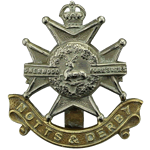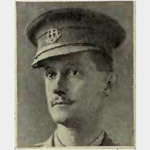Commemorated: | |||
| 1. Memorial: | Le Touret Memorial | Panel 26 and 27. | |
| 2. Book: | The (1921) Masonic Roll of Honour 1914-1918 | Pg.121 | |
| 3. Memorial: | The (1940) Scroll - WW1 Roll of Honour | 60C GQS | |
Awards & Titles: | Mentioned in Despatches | ||
Service Life:
Campaigns:
- The Second Anglo-Boer War 1899-1902, South Africa.
- The First World War 1914-1918, World-wide.
| Unit / Ship / Est.: Sherwood Foresters (Notts and Derby Regiment) |
1st Battalion August 1914 : in Bombay, India. Returned to England, landing Plymouth 2 October 1914. 2 October 1914 : moved to Hursley Park and attached to 24th Brigade in 8th Division. 5 November 1914 : landed at Le Havre. Note: brigade attached for purposes of giving instruction to 23rd Division, 18 October 1915 to 15 January 1916. |
| Action : The Battle of Neuve Chapelle and subsidiary actions |
Following a winter in the trenches the BEF was prepared to take the offensive against the Germans. The location was Neuve Chapelle, a small village in the front line below Aubers Ridge near Lille. Aubers Ridge was a low but significant hill and the intention at Neuve Chappell was to punch through the German front line, occupy the ridge and exploit with cavalry. It was a battle fought by two Corps of the BEF, the Indian Corps and IV Corps both largely consisting of regular battalions. It was to be preceded by the most violent artillery barrage of the war to date. Unfortunately in what was to be the start of the 'learning curve' for the BEF the artillery barrage, whilst violent, failed in some parts ? a failure that was to be costly and which delayed the assault and allowed the Germans to recover. Whilst the men were exceptionally brave they became bogged down as German machine guns and artillery stopped the momentum of the assault and by the end of the first day (10th March 1915) they were digging in. The following day the assault was repeated with fresh battalions but with no success. By the 12th March the Germans had recovered their poise, had brought in reserves and were ready to counter attack.
Neuve Chapelle (10-12 March 1915) was the first planned offensive battle by the BEF in France and achieved limited tactical success but not the expected breakthrough. It highlighted the problem of delay in execution that allowed the defending Germans to regroup, often consequent on small incidents and errors. Having stabilised the situation following the German sweep into France and the counter attack that eventually established static trench warfare on the western front, there was significant pressure on Britain to take a share of the burden from the French (who had without question had born the brunt of the fighting). Although the battle was effectively over by 12th March, the official battle nomenclature included actions in other sectors up to 22 April 1915 including the significant actions at St Eloi and at Hill 60 (Ypres).
See also: Christchurch College
Lieutenant, Derbyshire Regiment, Malta (1901)
Detail :
DIXON, Hubert Bradshaw, Captain, 1/Sherwood Foresters In St Giles Church, Great Longstone, Derbyshire there is a church bronze plaque above the first pier of the north arcade surmounted by the regimental badge, which is inscribed: In honoured memory of Hubert Bradshaw Dixon, Captain First Battalion Sherwood Foresters who lost his life while trying to save some of his comrades during the battle of Neuve Chapelle March 12th 1915. Aged 36 years and was buried in France. Hubert DIXON was educated at Retford College and was commissioned into the Derbyshire Regiment in 1899. By 1901 he was a Lieutenant in the Sherwood Foresters served in the South African War 1899-1902 for which he was awarded the Queen's Medal and four clasps. When the Great War started he was a student at the Staff College at Quetta (Now Pakistan).
On returning to the UK with the battalion he embarked to France on 4th November 1914. Following a winter in the trenches the BEF was prepared to take the offensive against the Germans. The location was Neuve Chapelle, a small village in the front line below Aubers Ridge near Lille. Aubers Ridge was a low but significant hill and the intention at Neuve Chappell was to punch through the German front line, occupy the ridge and exploit with cavalry. It was a battle fought by two Corps of the BEF, the Indian Corps and IV Corps both largely consisting of regular battalions. It was to be preceded by the most violent artillery barrage of the war to date. Unfortunately in what was to be the start of the 'learning curve' for the BEF the artillery barrage, whilst violent, failed in some parts ? a failure that was to be costly and which delayed the assault and allowed the Germans to recover. Whilst the men were exceptionally brave they became bogged down as German machine guns and artillery stopped the momentum of the assault and by the end of the first day (10th March 1915) they were digging in. The following day the assault was repeated with fresh battalions but with no success. By the 12th March the Germans had recovered their poise, had brought in reserves and were ready to counter attack. Possibly the most exposed and advanced post was called the Duck's Bill and it was held by 1/Sherwood Foresters.
In the early morning the Germans attacked in overwhelming force but were held by astonishing bravery by the BEF. The Duck?s Bill became a place of carnage with men surviving by whatever brutal means they could. The War Diary tells us that the German assault commenced at 0500hrs 12th March and the entry for 0700hrs says ?Battalion, in complete possession of its former line. During this action Capt. Dixon, 2nd Lts Shacklock and Walker were killed and Lt and Adjt Stranger and 2/Lt Binney wounded?. Captain Hubert DIXON was the officer commanding D Company. All four company commanders were hit in this action, DIXON being the last one of the four to become a casualty. His company defended the small orchard on left (east) flank of the battalion on the night 11-12 March. C Coy was immediately on their right and during the fight that rolled north on the 12th, survivors of all four companies (mixed in with a lot of Germans) were involved.
During this period between 0500hrs and 0700hrs Private Jacob Rivers of C Company 1/Sherwood Foresters was posthumously awarded the VC for his bravery in holding off the Germans using the rather unreliable hand grenades (bombs) with which the BEF was equipped. By this time ? the time of Private Jacob River?s VC action - it is clear that Dixon was the only company commander still on his feet as he was hit right at the end of the battle. In this action the 1/Sherwood Foresters losses were 90 killed, 265 Wounded and 87 missing (most of whom were dead). Of the 18 officers who went into action, 9 (including Dixon) were killed and 7 wounded.
He was Mentioned in Despatches (Gazetted 22/6/15), and is mentioned on the awards list of the 8th Division History of the Great War. His family received the British War Medal, Victory Medal, and 1914 Star after the war. He has no known grave and is commemorated Le Touret Memorial, France The 1921 Masonic Roll of Honour incorrectly lists him as Hubert P DIXON under Lodge 2129. He was a member of three lodges: DOROTHY VERNON Lodge No 2129 NORTHERN NIGERIA Lodge No 3325 (of which he was a Past Master) Lodge No 3710 He is one of 23 brethren killed at the Battle of Neuve Chappell 10-12 March 1915. Sources Steve Morse John Cotterill
Masonic :
| Type | Lodge Name and No. | Province/District : |
|---|---|---|
| Mother : | St. John & St. Paul No. 349 E.C. | Malta |
| Joined : | Dorothy Vernon No. 2129 E.C. | Derbyshire |
| Joined : | Northern Nigeria No. 3325 E.C. | Nigeria |
| Joined : | Deolali No. 3710 E.C. | India |
| Joined : | Army & Navy No. 3651 E.C. | India |
| Joined : | McMahon No. 3262 E.C. | London |
| Joined : | Zungeru No. 3506 E.C. | Northern Nigeria |
Initiated | Passed | Raised |
7th January 1901 | 4th February 1901 | 19th February 1901 |
Initated into St. Johns & St. Pauls Lodge No. 349 in Malta. Joined Dorothy Vernon Lodge No. 2129 on 1st March 1904. Petitioning and Founder Worshipful Master of Northern Nigeria Lodge No. 3325, joining at consecration on 3rd July 1909. Recorded "Killed in action 12th March 1915" on its register.
Petitioning and Founder member of Zungeru Lodge No. 35065, Northern Nigeria on 13th May 1911. The warrant of this Lodge was erased 4th March 1914. Petitioning and Founder member of Army and Navy Lodge No. 3651 on 28th April 1913. Recorded as "Killed in Action 12/3/1915" on L3651 register.
Joined McMahon Lodge No.3262 at Quetta on 16th April 1914, but resigned by September of the same year.
Past Master of L3325 & 3710
Source :
The project globally acknowledges the following as sources of information for research across the whole database:
- The Commonwealth War Graves Commission
- The (UK) National Archives
- Ancestry.co.uk - Genealogy, Family Trees & Family History online
- ugle.org.uk - The records of the United Grand Lodge of England including the Library and Museum of Freemasonry
Additional Source:
- Founder Researchers : Paul Masters & Mike McCarthy
- Researcher : Bruce Littley

